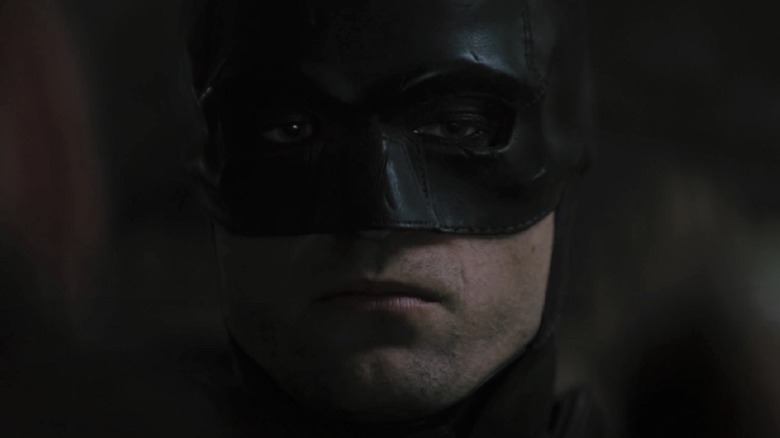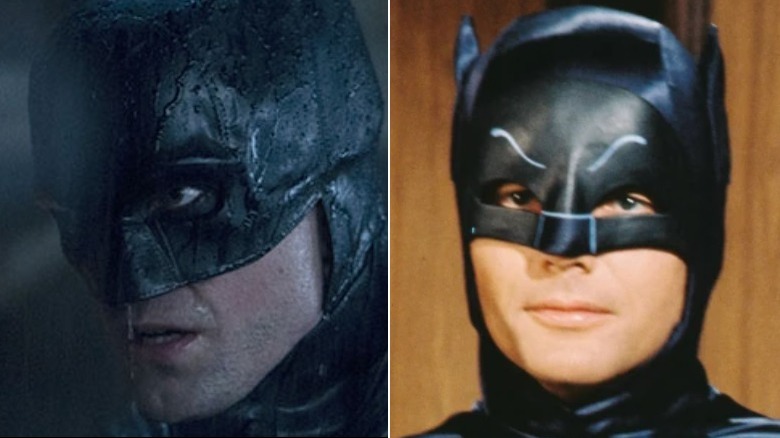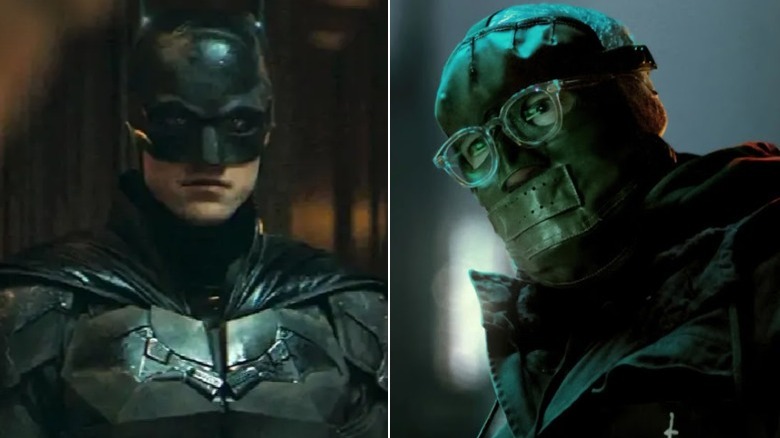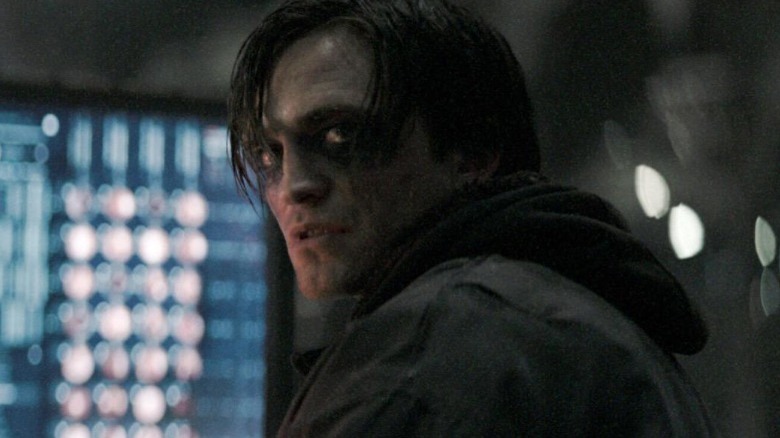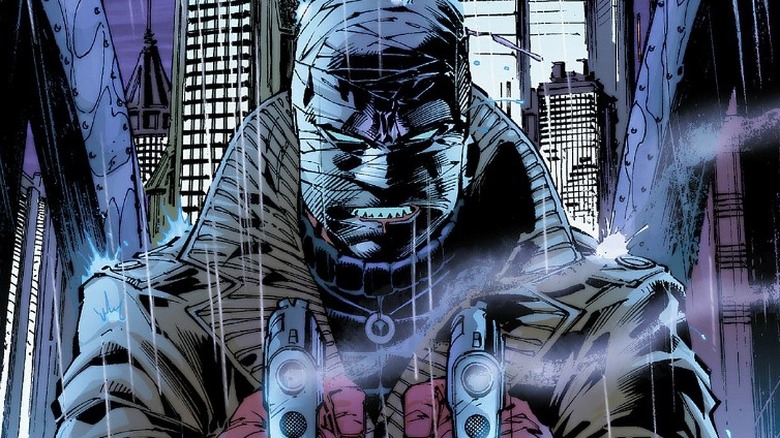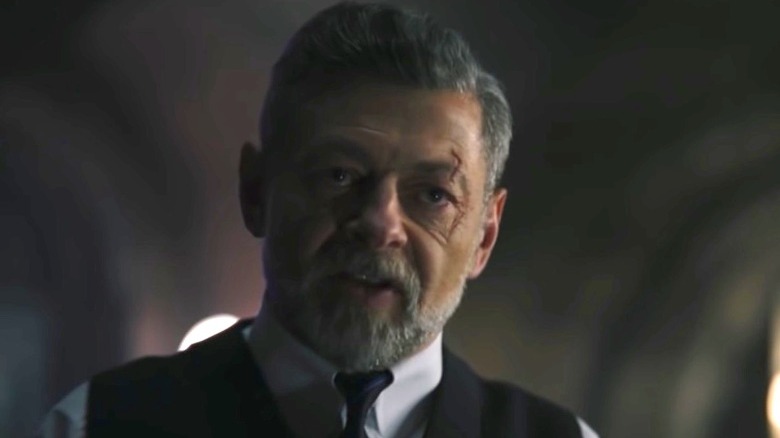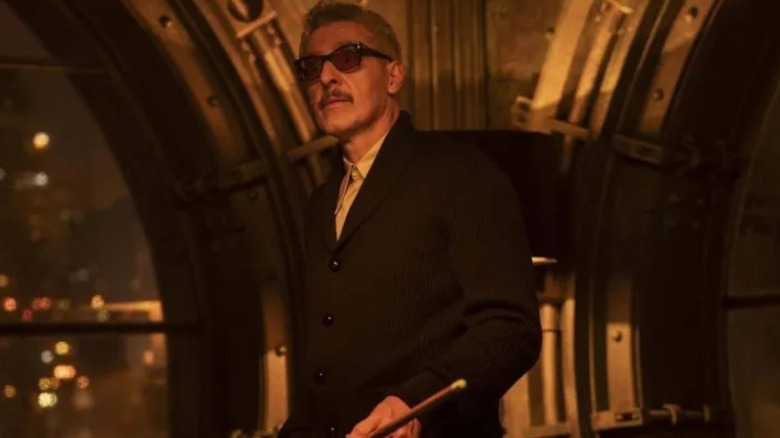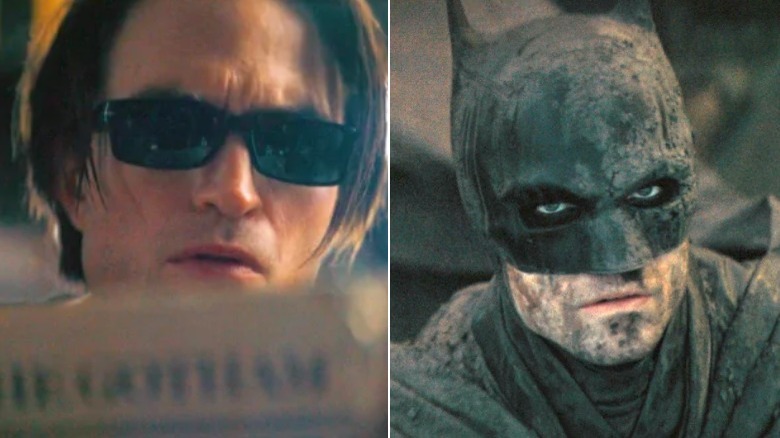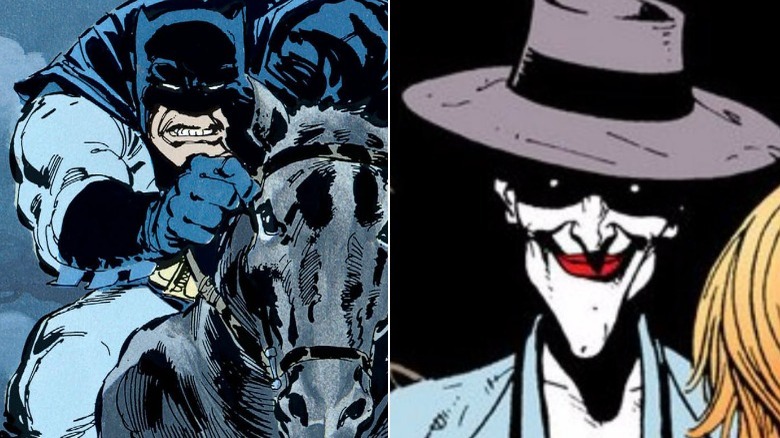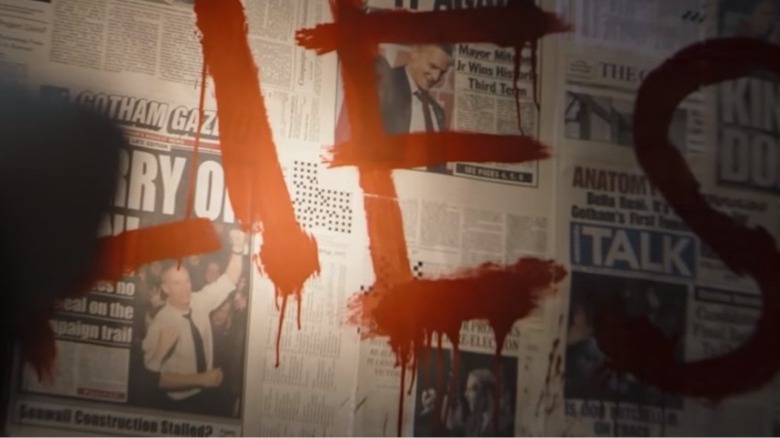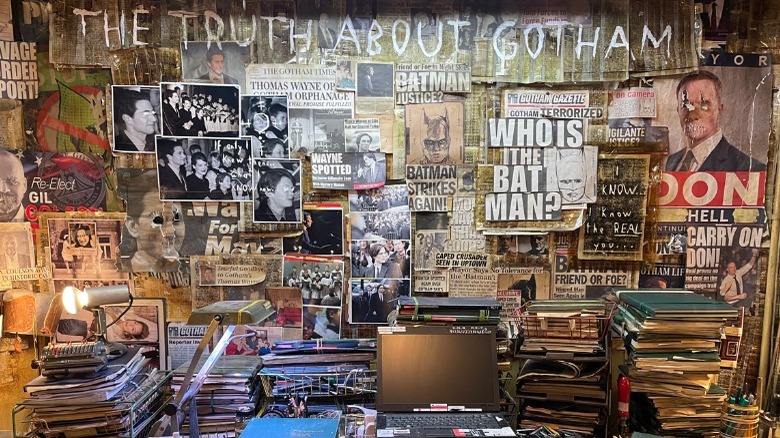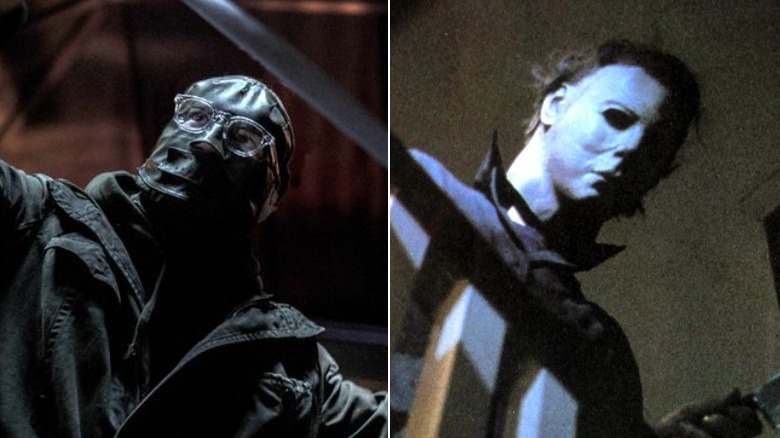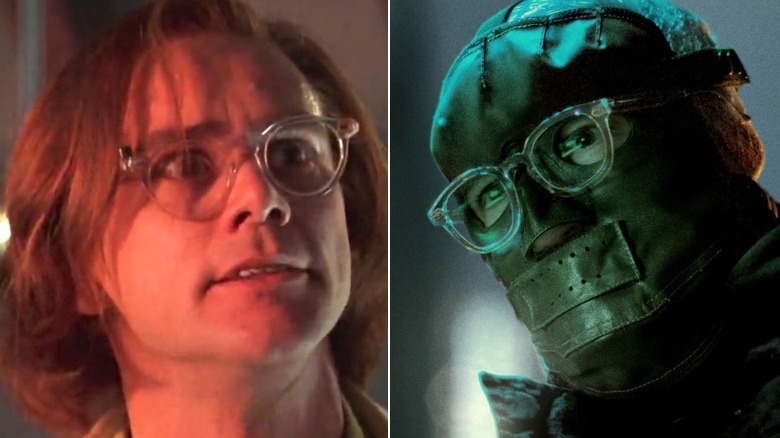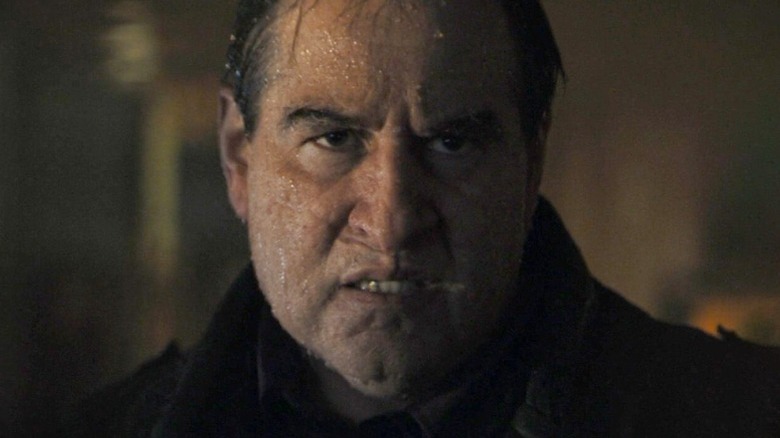Things You Only Notice After Watching The Batman Twice
The grime and filth of Gotham's darkest corridors emanate from the screen in "The Batman," Robert Pattinson's first outing as DC's Dark Knight. The critically acclaimed film thrusts viewers headfirst into a dreary urban hellscape with perpetually overcast weather — at least until the film's third act. Bruce Wayne uses the shadows to strike fear into the hearts of criminals, who know that he could be lurking in them. In another corner of Gotham, the Riddler does the very same.
The world that director Matt Reeves created is a living, breathing biosphere with a history entirely of its own making. There's a certain beauty in the bleak tones: Gotham City has never looked more magnificent in all of its decay, highlighted by the neon glow of commercialism. For the most eager Bat-fans, the filmmakers have included countless details that connect the story's themes, reference a larger Gotham, and acknowledge Batman's legacy on screen. Of course, spotting all of these subtle details might take multiple viewings. Let's dive into some of the less obvious nods that audiences might only notice after sitting through the film for a second time.
The Dark Knight's new look was inspired by Adam West's Batman
Robert Pattinson's Batsuit is one of the most functional-looking to date, but it's partly inspired by a much older design. Modern filmmakers know that Batman needs to be decked out in armor to deflect bullets (he isn't Superman, after all), but his Batsuit still needs to feel familiar to audiences. Perhaps the most recognizable aspect of Batman's attire is his cowl.
Unlike the ones worn by Christian Bale and Ben Affleck, Robert Pattinson's cowl isn't one seamless mold. Instead, it's multiple pieces stitched together. This reflects the homemade nature of his outfit (this is an early-years Batman, let's not forget), but there's more to it than that.
When you take a closer look at the cowl seen in "The Batman," you'll notice that the nose piece is flat and stitched onto the headwear. If it looks oddly familiar, that's because Adam West's Caped Crusader wore a similar cowl. Matt Reeves confirmed in a Q&A (via Insider) that the new cowl was inspired by the one worn by West in the classic '60s TV show, which he grew up watching.
The Riddler is a warped mirror image of Bruce Wayne
Every Batman story needs a solid villain, and "The Batman" has exactly that. The Riddler bludgeons his way through Gotham's corrupt leadership, leaving a trail of clues for Batman. On the surface, the Riddler is a madman exacting brutal revenge upon those sucking the life out of Gotham. In reality, he's simply emulating the Dark Knight — the Riddler even states that Batman inspired him.
A closer inspection of the Riddler's crusade reveals just how similar he and Batman are. For starters, they both hide behind masks, which (according to the Riddler) allows them to be their true selves. Both are orphans with personas born from tragedy, a major plot point in the film. They both hold a deep hatred of the corrupt. Batman brutalizes his enemies, while the Riddler violently murders them.
Whether Bruce Wayne likes it or not, he and the Riddler are similar. Both men are on a quest for vengeance, a word that holds significant meaning for the Dark Knight. It's only when one of the Riddler's followers claims that he's "vengeance" that Batman sees the awful mirror image and realizes he must elevate his mission to one of hope.
Robert Pattinson's Bruce Wayne fits the Nirvana-themed soundtrack
"The Batman" has a killer yet thoughtful score centered around the Nirvana song "Something in the Way." The contemplative guitar strums of the song (from the band's classic album "Nevermind") are often precursors to new, grand revelations in the film. The heavier beats of some of Batman's more intense moments even mimic the pattern of the song. It's a poignant reminder that Batman is spinning his wheels, so to speak, in his war on crime.
Early in "The Batman," Bruce Wayne states that he's not really making much of a difference in Gotham. After two years as Batman, he hasn't made any lasting changes to the city. Innocents fear him just as much as the crooks do. That's mainly because he hasn't defined a mission beyond vengeance. There's "something in the way," and he can't seem to pinpoint the issue.
The song featured heavily in the trailers, and it ended up being a big part of the film itself. Now, the two will be forever linked. It's also worth pointing out that Bruce Wayne personifies the late Kurt Cobain in many aspects, with his reserved demeanor and grungy appearance nodding to the Nirvana frontman.
Tommy Elliot's Hush is set up by the Riddler
There's a change in the wind as "The Batman" fades to black and the credits roll. The Riddler unearthed plenty of dirt on Gotham's leaders and wealthy families during the film, including the Waynes. He revealed that Thomas Wayne worked with Carmine Falcone to silence a reporter by the name of Edward Elliot. We later learn that he never intended for Falcone to kill the man and was filled with guilt when he found out what had happened, but that's not what the public saw from the Riddler. What you may not have noticed upon your first viewing of "The Batman" is that the Riddler teased the rise of Tommy Elliot's Hush.
The villain daubed the word "hush" over an image, which is shown as he's discussing the murder. Whatever Tommy Elliot's relationship with Edward may be in this world (father, brother, nephew), the Riddler has provided him with plenty of reasons to hate the Wayne family, just like his comic book counterpart. Even if proof emerges that Falcone murdered Edward Elliott without Thomas Wayne's knowledge, Bruce's father once performed a lifesaving operation on the criminal, which could be enough to trigger his hatred. Tommy could then take the moniker of Hush from Riddler's photo as he embarks on a bloody conquest. It's all right there, ready to go for a sequel.
Alfred has a scar on his eyebrow
Batman always has a few allies, despite his lone wolf act. Most importantly, Alfred has always been by the Caped Crusader's side, supporting him in all manner of ways. This version of the loyal butler appears to be more of a family bodyguard. Alfred even tells Bruce that it was his duty to protect Thomas and Martha, lending credence to this idea. He also states that he taught Bruce how to fight. Batman's combat prowess is there for all to see, so Alfred is likely a skilled fighter himself. The "Batman: Earth One" graphic novel features a version of Alfred that trained Bruce in all that he knows as he was a former operative in the S.A.S.
At the beginning of the film, a minor detail concerning Alfred's face may go unnoticed initially. Viewers who examine his left eyebrow will see that he has a scar or abrasion of some sort. This is long before he takes the brunt of the Riddler's bomb in Wayne Tower. The scar could be from his past, or perhaps Alfred has assisted Batman in the field, just as he did in "Batman: Earth One." It's a mystery for now, but it's definitely a visual cue that indicates a violent history.
Did Carmine Falcone know Batman's identity?
"The Batman" establishes that Carmine Falcone had a history with Thomas Wayne. In the film, Falcone recalls Bruce's physician father operating on him in the Wayne household and how he saw a young Bruce looking down on the scene from the staircase. The mobster indicates that he and Thomas were close, but Bruce isn't having any of it: The younger Wayne says that all it means is that his dad took the Hippocratic oath.
Later, Batman apprehends Falcone and brings him out into the open, where he gets shot by the Riddler. The Dark Knight is looking down at the gangster as he draws his final breath, and Falcone appears to realize something just before he dies. One could argue that he's simply in shock having been shot, but Falcone has a distinct look of surprise on his face as he gazes up at the Dark Knight. Could it be he just realized that Bruce Wayne is the Batman? It seems to bring the story that Falcone told Bruce earlier in the film full circle — the young Bruce was looking down on Falcone as his father operated on him, after all. If true, it's a subtle but poetic detail that gives some extra weight to the villain's death.
Bruce Wayne literally embraces the light
Batman has undergone a transformation by the time the film comes to a close. In the beginning, his mission was in desperate need of some better PR: When the innocent people in Gotham are afraid of the Caped Crusader, that's a bit of a red flag. At first, audiences loved Batman's brutal quest for vengeance, but, like the vigilante himself, viewers soon realized that a hero needs more than just anger to do good in the world.
The early parts of the film show a soul who is just as crushed and defeated as those attempting to survive in the worst parts of the city. Bruce is angry. His hatred of the criminal element is on full bone-crunching display as he viciously pummels bad guys into the ground. He's a creature of the night who only feels comfortable in the shadows. This is apparent when Bruce is seen walking around indoors during daylight hours with sunglasses on. He's either sensitive to the light from long nights in the dark, or he and the light simply don't mix.
In the third act, he begins to embrace a new purpose, intent on providing hope to the people of Gotham. He leads the humanitarian efforts as the city reacts to the flooding caused by the Riddler. Gone are the rage-filled days of vengeance. This is a new Batman who isn't afraid to be out during the day, a symbolic echo of the character's growth.
Thomas Wayne's cease-and-desist letter references famous Batman writers
The Riddler goes after the Wayne family hard when airing Gotham's dirty laundry. He alleges that Thomas Wayne had a journalist murdered in cold blood. The reason? The journalist had information about Martha Wayne's psychiatric struggles, and he would go public with it during Thomas Wayne's mayoral campaign. Alfred clears up the messy story for Bruce, explaining that Thomas didn't care about the campaign, only about the harm that the information would do to his wife. He did ask Falcone for help dissuading the reporter from publishing, but only as a last resort.
Thomas went through the proper channels at first, even sending a cease-and-desist letter. A portion of that letter is shown up close in one scene: It was sent from the Miller & Moore law firm. Comic book fans will immediately recognize those names as references to Frank Miller and Alan Moore, who wrote "The Dark Knight Returns" and "The Killing Joke," respectively. Both are prolific comic book writers who have made significant contributions to the world of Batman over the years, and this was a nice nod to their legacies.
The Riddler's plot to blow up the seawall is foreshadowed
The Riddler's plot to destroy Gotham's seawall and flood the city was in the works for quite some time, it would seem. Late in the film, we learn that he's been planning a series of devastating explosions with other radicals online. However, one long-since-passed event set the stage for the seawall being an exploitable tool for the Riddler. It turns out that the funding provided by the Renewal Project (which has been siphoned away by the corrupt) was supposed to go towards the upkeep of the seawall, confirmed in a blink-and-you'll-miss-it moment.
In an image of newspaper clippings that flashes up on the screen, one headline is noteworthy: "Seawall Construction Stalled?" This headline indicates that seawall safety was put on the backburner when the funding mysteriously vanished. It left the wall vulnerable, and the Riddler knew it. The greed of those in power left the city in a dangerous position, and the villain was happy to exploit it.
One robber's Halloween mask is a nod to Gotham's drug problem
Early in "The Batman," Bruce Wayne discusses his bleak outlook for Gotham against a montage of thugs committing crimes all over the city. One of these crooks is robbing a convenience store while wearing a green mask that looks like an oval jack-o-lantern. This mask comes across as inconsequential the first time you watch the movie — it's Halloween night, after all, and the robber wants to hide his face for obvious reasons. We come to realize that this is no store-bought Halloween mask, however.
The mask actually resembles a "drop," the fictional drug that is plaguing Gotham. They are administered through the eyes, and they are apparently highly addictive. The city is running a campaign against the drop epidemic (the mask resembles an image of a drop seen on a billboard), but it doesn't appear to be helping much, with criminals leaning into the iconography to instill fear in others.
How the Riddler mimics Michael Myers
The Riddler is an enigmatic killer shrouded in mystery. Once Batman begins following the trail of clues and carnage, he learns more about the villain and what he's really after. While the Riddler clearly has a motive in mind, his style is akin to the fictional serial killer that made a big splash in 1978's "Halloween."
In the opening moments of "The Batman," we're given a voyeuristic view through the Riddler's eyes. We hear steady breathing from behind his mask, much like the young Michael Myers. The Riddler then stalks the mayor, waiting in the shadows. He jarringly emerges and brutally murders his victim in true Michael Myers fashion.
Later in the film, another famous "Halloween" scene is replicated when D.A. Gil Colson becomes the Riddler's next victim. The unsuspecting lawman gets into his car, but he's not alone. The Riddler is waiting in the back seat, and by the time he notices, it's too late. While he doesn't kill him there and then, it's a parallel to Annie Brackett's death in the slasher classic. Matt Reeves has confirmed that he took cues from several '70s films, with "The French Connection," "Chinatown," and "Taxi Driver" all inspiring him.
The Riddler wears the same glasses as Jim Carrey's Edward Nygma
Jim Carrey portrayed a far more eccentric version of the Riddler in Joel Schumacher's "Batman Forever," a film that couldn't be more different from "The Batman" in terms of approach. While "Batman Forever" is generally considered one of the worst Batman movies ever made, many critics praised Carrey's performance, with his over-the-top antics suiting the style of the movie.
It appears as though Matt Reeves and the costume designers who worked on "The Batman" decided to honor Carrey's take on the Riddler with a simple design choice: Paul Dano's version of the character wears the same glasses. The clear-framed spectacles he's seen in look almost identical to those briefly worn by Carrey's Edward Nygma before he goes down his villainous rabbit hole. It's a subtle but clear nod to the character's history, and you may not be able to look at Paul Dano's version of the Riddler the same way again as a result.
The Penguin waddles like an actual penguin
"The Batman" might paint a bleak portrait of a city drowning in its own filth, but there are still a few moments of levity in there. The Riddler cracks a rather morbid joke near the start of the film, attaching the mayor's actual thumb to a thumb drive. Jim Gordon is also quick to hit those sarcastic notes, offering viewers the odd chuckle.
After Batman uses the Batmobile to flip Penguin's car in a thrilling chase sequence, he and Gordon begin to interrogate the crooked club owner. They believe that he's the one who ratted on the Maroni crime family, longtime rivals of the Falcone family. Of course, the Penguin insists that he isn't the rat and is even disgusted by the suggestion. He also unintentionally gives Batman a new lead.
When Batman and Gordon exit the scene, they leave Penguin standing there with his hands and legs tied. It's one of the funniest moments in the movie — the Penguin waddles like an actual penguin as he yells at the departing good guys, a choice that must have been intentional.
